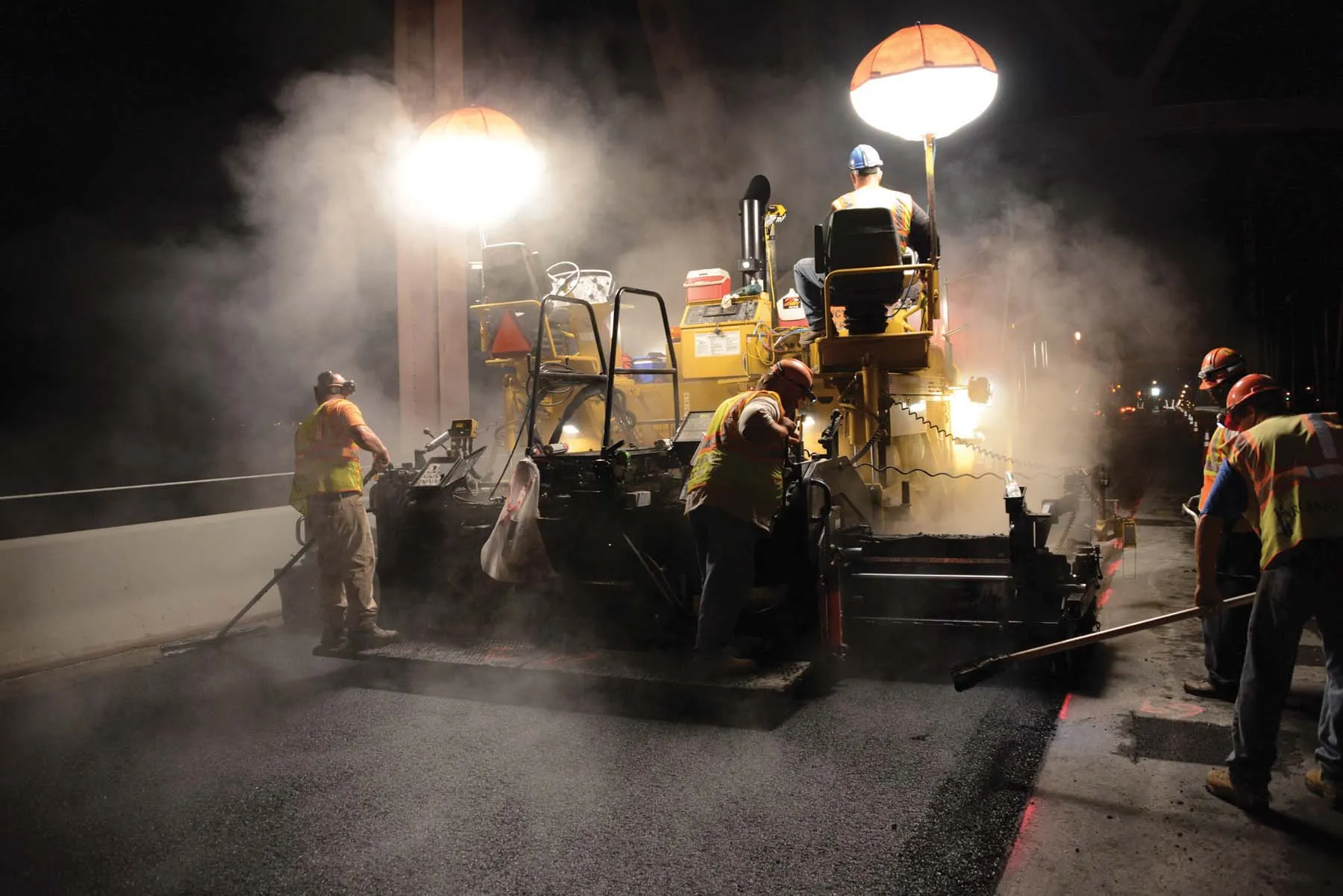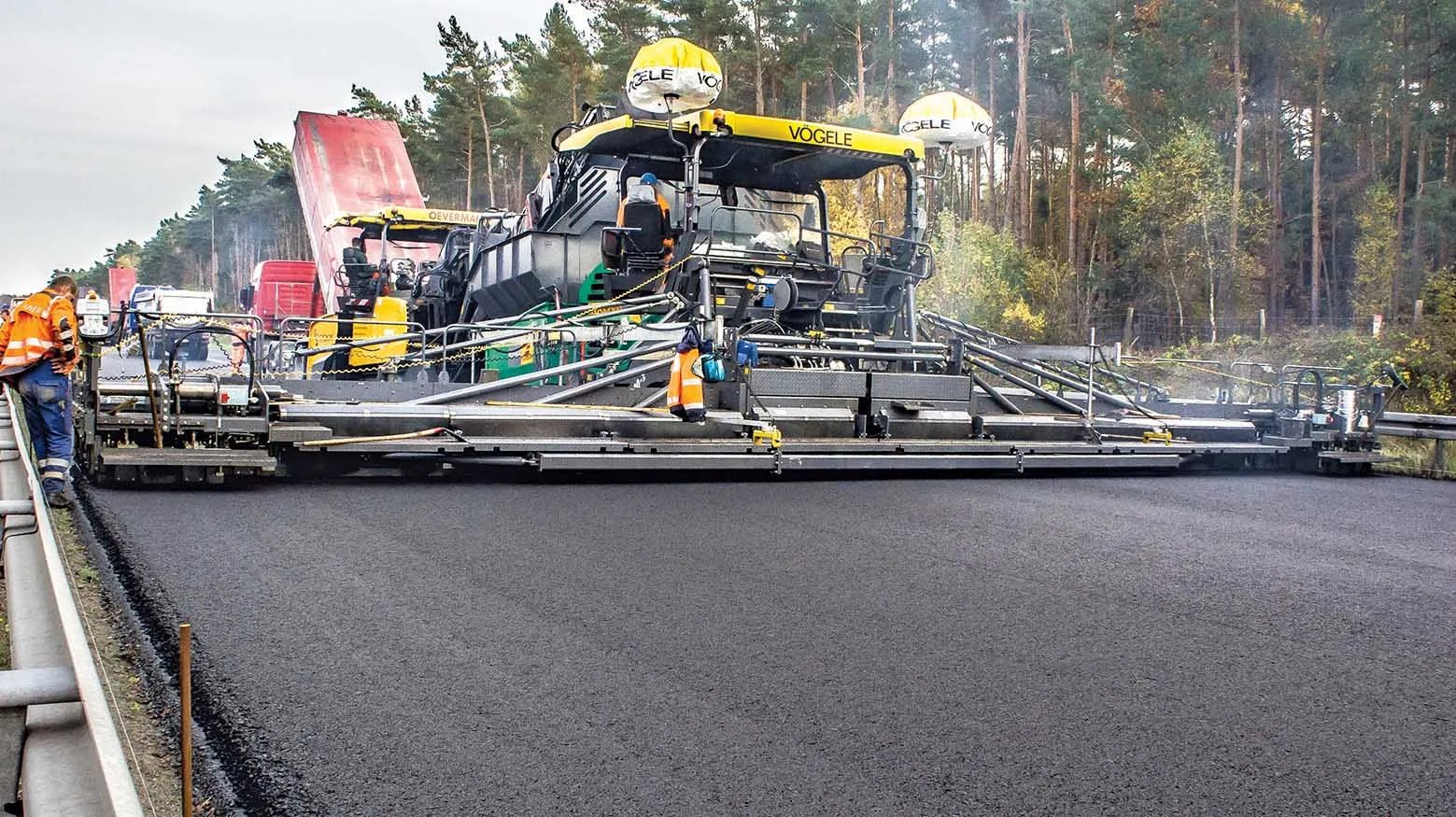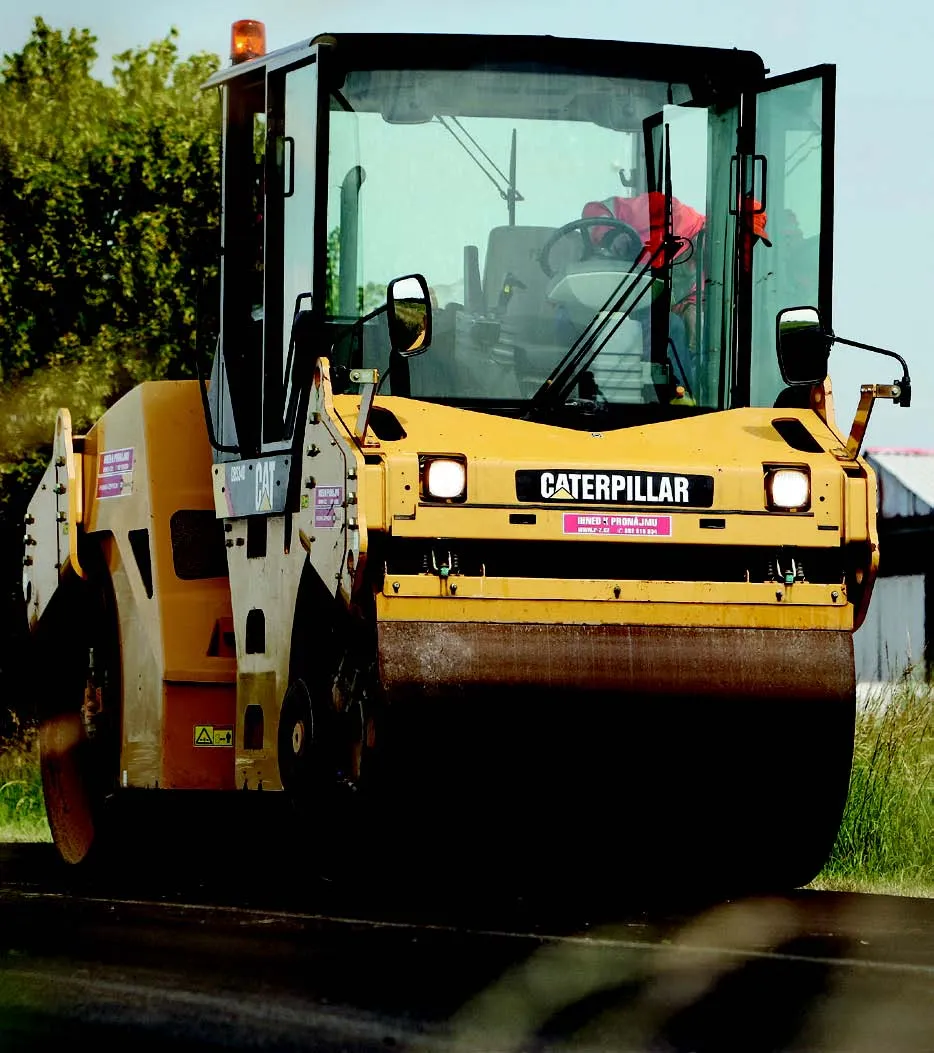
As roads become more congested, the user cost of daytime lane closures to accommodate road construction and paving has increased dramatically. One solution to lower user costs associated with traffic delays is to carry out more paving at night during off-peak times. However night-time paving brings new challenges to producing quality work in safely.
The primary quality challenge for night paving stems from reduced lighting, as it is more difficult to see the quality of the asphalt mat being placed due to shadows cast by artificial lighting. This makes it hard to see and correct segregation occurring at the paver or to see mat texture differentials and make the necessary screed adjustments.
With cooler ambient temperatures at night, greater consideration must be given to mix temperature. The temperature of hot-mix asphalt (HMA) during the rolling operation will largely determine how successful the compaction and smoothness operations will be. Several practices, such as tarping loads, keeping windrows to two truckloads or less, maintaining a full paver hopper of HMA, and using end dump trucks will help maintain mix temperature, as will higher mix production temperatures. All of these factors must be considered when working at night and in general, best practices related to paving in cold weather also apply to night paving.
Longitudinal joints require particular attention at night. Operators should roll from the hot side as soon as possible and closely examine the compacted joint to ensure that there is a flush surface with the adjacent lane. Rollers can be fitted with additional lights aimed at the edge of the drum to allow the operator to have a better view of the joint.
The human body clock gets confused and crew members may not have the proper amount of sleep when working night shifts. This leads to worker fatigue, particularly during the first week until bodies adjust to a schedule. Some workers adjust more quickly than others, while others never fully adjust to working at night.
Switching back and forth from days to nights is physically and mentally demanding so contractors should try to maintain continuity in shifts as much as possible. There is a risk of sleepiness that usually sets in from 2-4am when the ability to think clearly and remain alert can be impaired, so keeping a coffee urn on the paver at night for the crew can be a major help. Once daybreak comes, personnel tend to wake up and feel re-energised
Another challenge with night-time paving is trucker awareness. Some truck drivers work both day and night, going with little or no sleep, making them more dangerous on the road and on the jobsite. From a production standpoint, some truckers will leave the job early to get some sleep before going to a daytime job. This can create production challenges and job penalties if their action results in paving delays that prevent opening lanes to traffic by the morning deadline.
But despite the drawbacks, there are plenty of positive aspects to night-time paving. Reduced fuel and electricity costs for operating HMA plants during off-peak hours can cut costs, although these potential savings may be negated by higher mix temperature requirements. There can be less traffic in and out of the jobsite and shorter truck cycle times due to reduced congestion on the road and at the plant.
There are issues that have to be recognised from working in the dark including a reduced ability to see and correct mat defects, an inability to view truck beds or see the paver augers as well to identify and correct any segregation problems. In addition a tack coat takes approximately 1.5 times longer to cure at night, so crews should be aware of this and plan accordingly to avoid the team sitting idle while this cures. Meanwhile matching the joint between adjacent lanes is more difficult because of reduced visibility and depth perception and the loader operator will have more difficulty seeing stockpiles to minimise segregation.
The colder temperatures at night cause HMA to cool faster requiring higher production temperatures, while quality control and plant personnel do not have a good view of cold feed operation. In addition, the plant operator cannot see the external components of the plant as well at night. There is an increased safety liability because of reduced visibility and there are increased labour costs for paying shift premiums to the crew and truckers. Restricted lane closure times and tight paving windows can result in stiff penalties for failing to open traffic lanes on time. Some estimates show that night-time paving increases cost by approximately 20%. The main cost increases are typically attributed to shift premiums paid to workers and the need for additional lighting.
To ensure machine reliability, mechanics should be available on-site all night due to difficulties in calling for help or parts if there is an equipment problem. Work zone vehicles should have safety lighting, such as high-intensity strobe lights and flashing or rotating beacon lights. Additional fluorescent lighting or spotlights are required on the equipment along with portable light towers to improve visibility of the mat. Light plants often require an additional person to keep them fuelled and move them along with the paving spread throughout the night.
The paving plan should include a separate lighting plan and careful placement of the lights is necessary to avoid dazzling motorists. All crew members should understand the paving and lighting plans before the shift.
The crew chief should drive through the work zone after it is set up and check that motorists will be able to understand the work being carried out and the dangers of the working area. Traffic control personnel are often required by contract at night and signs blow over and cones get knocked down, so the team should constantly scan the working area to ensure that all signage, cones and safety lights are in place. Additional safety considerations include clearly delineating the work zone so that drivers do not become confused as to which lane they should be in, as well as ensuring site personnel wear reflective clothing and hardhats.
Some safety managers have implemented a program where emergency flares are placed adjacent to the paving operation as it moves along. This is an effective method of reducing the speed of vehicles passing the through the work zone and increasing driver awareness as they pass close by the paving team.
One crew member should act as a spotter for manoeuvring the paver or other equipment in tight spots or areas where operator visibility is reduced, such as in front of a windrow pickup machine. Large material transfer vehicles have limited visibility at night and the entire crew should assist the operator with this vehicle. The team needs to look out for one another and know where everyone else is at all times, with zero tolerance for unsafe work practices.
Night paving presents several different challenges, but attention to detail and a well-developed paving plan that gives strong consideration to the human factors of working at night will result in a project equally successful to any daytime project.









